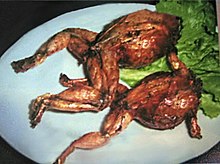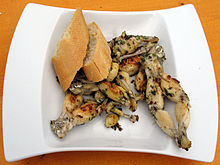Frog (food)
Frogs are considered a delicacy in the kitchens of France , western Switzerland , Belgium , Luxembourg , Portugal , Louisiana and the Caribbean as well as generally in South and East Asia and parts of Africa . Usually only the hind legs called frog legs with the attachment of the spine of different species are used, especially from the family of real frogs (Ranidae) and their close relatives.
background
An old cookbook says: “The extremely tender calf meat of frogs tastes almost like that of young chickens. It is a little fatter and softer, but this is more pleasant than adverse. The meat of the frogs is tender and fine. They are best in autumn, when the frog is best fed. A dozen of them are lined up on rods and sold on the market. "
The economic encyclopedia by Johann Georg Krünitz from the 18th century also mentions the consumption of frogs and gives appropriate recipes. Krünitz also describes the hunting methods; usually a special crossbow called the frog sniper was used for frog hunting . The “funniest” thing, however, is to catch frogs with a so-called Klitsch fishing rod, which uses a red cloth as bait . The preparation is also described:
“When preparing the frogs for eating, the front part is cut off completely, the skin is peeled off over the rear part, the front part is chopped off the latter, and placed in cold water for a night to soak it out; then these hind quarters are fricassed with their backs, sprinkled with flour or semolina, and baked from lard, or prepared like young chickens. "
According to Krünitz, frogs were already being eaten more frequently in Italy and France than in Germany at that time, but Meyer's Konversationslexikon can still be read at the end of the 19th century: “In southern Germany and all of southern Europe, the thighs are boiled as a tasty, easily digestible and healthy dish and eaten fried; in Italy the whole eviscerated frog is eaten ”.
In Asian cuisine, for example in the Philippines or Cambodia , frogs are also served whole and filled. For this purpose , minced pork mixed with garlic , vinegar and spices is poured into the well-cleaned interior of the frogs, rubbed with spices and hung in the sun to dry. Then the frogs are fried in hot fat until they are golden brown.
Origin, buyers from western countries
While frogs were still caught for consumption in Europe until the 20th century - namely water frogs like Rana kl. esculenta or Pelophylax kl. esculentus - today they are mainly imported from Asia, mainly wild-caught from rice fields and the wild, and frogs from so-called breeding farms. From a formerly seasonal trade for the respective local market, the frog legs trade has now developed into a year-round and global mass business. Formerly, India and Bangladesh , the major exporters, today Indonesia taken over this role. The main customer in Europe is France with around 150 million frogs' legs per year. Around 150 tons of frog legs are imported into Switzerland every year. In 1999, 9,700 tons of frog legs were imported into the European Union - mainly to France, Belgium and Luxembourg. Within one year, however, six million Chinese bullfrogs ( Hoplobatrachus rugulosus ) were shipped from Thailand to Hong Kong . In 2015, only 4,234 t were imported into the EU, mainly the legs of Indonesian crab frogs for France.
The United States imported nearly 15 million amphibians and over 5000 tons of amphibian parts from wild-caught animals from 1998 to 2002. 4000 tons of this was used for human consumption. This makes the United States one of the largest importers of frogs' legs, with around 20 percent coming from Asia. The most important exporter, Indonesia, exported around 3800 tonnes of frog parts in 2002 alone, mostly wild-caught. The largest buyer of Indonesian frog legs is Europe with a share of over 83 percent of this country's exports.
Animal protection, species protection and nature protection
Nature and animal welfare organizations criticize the methods of slaughtering the frogs used for consumption, which are described as cruel and cruel to animals. The abdomen of the living frog is often separated from the rest of the trunk by a fixed knife blade. The unused front part of the still living animal (head and torso with front legs) is usually discarded.
The massive removal of wild frogs from the landscape is also problematic, on the one hand under aspects of species protection and on the other hand because of interferences in the ecological balance . In Bangladesh, for example, mosquito plagues were reported after frogs had been captured on a large scale from rice fields and swamp areas. This in turn made the use of large quantities of insecticides necessary. In India, the legal trade in frogs' legs was discontinued in 1987, partly for reasons of animal welfare and species protection. However, illegal trade flows from India still exist.
In Germany, all European species of amphibians , including all frogs, are “specially protected” according to the Federal Species Protection Ordinance (BArtSchV), Annex 1, and the Federal Nature Conservation Act (BNatSchG), unless they are already “strictly protected” according to BNatSchG. Non-European species that are important for the food trade, such as the farm-bred North American bullfrog ( Rana catesbeiana or Lithobates catesbeianus ) and the often wild-caught Asian bullfrog (also: tiger frog; Hoplobatrachus tigerinus ) are particularly protected under the BNatSchG. (Other species that are exported or locally traded to a large extent include the Philippines frog , Fejervarya cancrivora , the Southeast Asian rice frog , Fejervarya limnocharis and the toothed frog , Limnonectes macrodon .)
"Particularly protected" means that representatives of this species must not be caught, injured or killed. However, the provision only covers the area of application of the law, i.e. Germany. The importation of some species is not affected, provided that they are not covered by international protection provisions such as the Washington Convention on the Protection of Species , such as Hoplobatrachus tigerinus .
Web links
Individual evidence
- ↑ Bernhard Kathan : Disappeared and rare guests on the menu. A cookbook , on-site, Innsbruck 1992 ( Frogs ( Memento from June 11, 2007 in the Internet Archive ))
- ↑ a b Frosch , Oeconomische Encyclopädie von Krünitz, Volume 15, 1778/1786, p. 174
- ↑ Frösche , Meyers Konversationslexikon, 1885-1892, p. 751
- ↑ a b c d Ian G. Warkentin, David Bickford, Navjot S. Sodhi, Corey JA Bradshaw: Eating Frogs to Extinction ( Memento of the original from January 31, 2012 in the Internet Archive ) Info: The archive link was inserted automatically and has not yet been checked . Please check the original and archive link according to the instructions and then remove this notice. (PDF; 182 kB), Conservation Biology 23, 2009, pp. 1056-1059 (English)
- ↑ frog legs. A delicacy with many question marks , interpellation 09.4290 by Maya Graf from December 11, 2009
- ↑ Der SPIEGEL 11/2017, p. 104: footnote
- ↑ WWF background information: Global amphibious crisis . December 2006 (PDF-online; 236 kB)
- ↑ a b z. E.g .: www.aktiontier.org
- ↑ Overview of the legal protection status of species of real frogs at wisia.de
- ↑ Entry on Hoplobatrachus tigerinus at wisia.de



